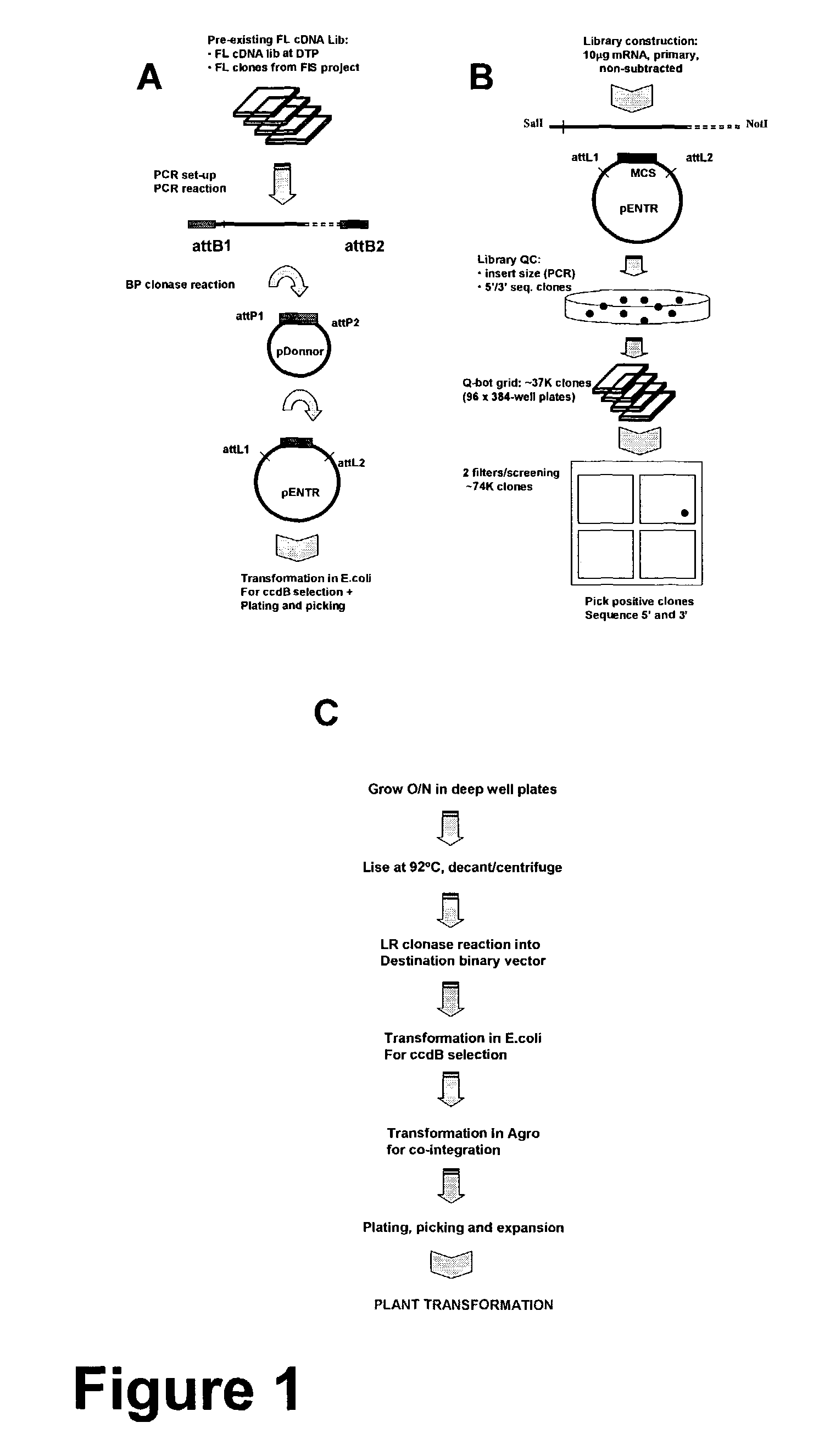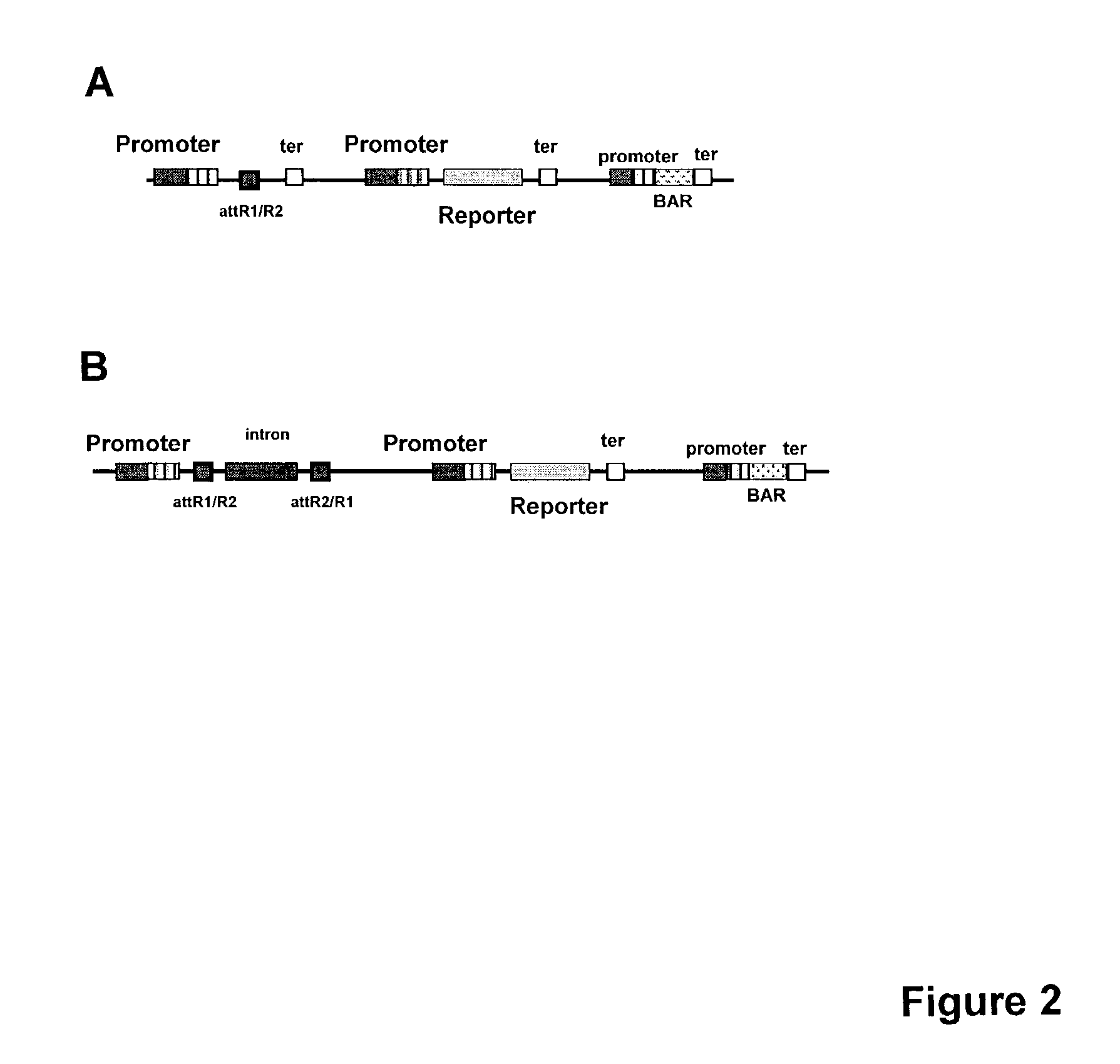Methods for large scale functional evaluation of nucleotide sequences in plants
a nucleotide sequence and large-scale technology, applied in the field of large-scale functional evaluation of nucleotide sequences in plants, can solve the problems of ineffective gene knockout methods or transposon tagging for multiple gene families, time-consuming, and ineffective gene knockout methods or transposon tagging, etc., to achieve rapid and efficient design and construction.
- Summary
- Abstract
- Description
- Claims
- Application Information
AI Technical Summary
Benefits of technology
Problems solved by technology
Method used
Image
Examples
example 1
Transformation with Multiple Gene Expression Vectors for Functional Genomics Study
Immediate Experimental Objectives:
[0124]To test the concept of transformation with multiple gene vector or a defined gene expression library:
1. Transformation simultaneously with multiple vectors using a model maize genotype to produce a large population (number) of transgenic events for gene expression analysis.
[0125]2. Analyze the transgenic population using molecular and phenotypic tools to test how the gene expression vectors are represented in the transgenic event population, and particularly to test whether all the gene expression vectors are equally or near-equally represented in the transgenic event population.
3. Analyze the transgene profile in transgenic events to see whether each of the majority of transgenic events represents a particular transgene.
Transformation Method:
[0126]Maize transformation experiments were performed using a standardized, high-efficiency Agrobacterium-mediated transfo...
example 2
Gaspe Flint Hybrid Maize Transformation and Transgenic Evaluation
[0145]Our initial experimental objective was to evaluate and establish an efficient transformation system for Gaspe Flint (GF) maize or a cross with GF maize. The small ear size of Gaspe Flint produces very limited number of embryos for transformation. However, Gaspe Flint is a very good pollen producer. Cross GS3 or A188 ears with Gaspe Flint pollen produced ears with excellent seedset that are as good as GS3 or A188 ears from selfing or sibling pollination. Thus, immature embryos from crosses of GS3xGaspe Flint and A188xGaspe Flint were used as Agrobacterium transformation target tissue in our initial transformation experiments.
[0146]F1 embryos were transformed with Agrobacterium-mediated transformation method using standard protocols established for GS3 and A188. Two Agrobacterium vectors, PHP10525 (35S::BAR / / Ubi::GUS) and PHP10626 (35S::BAR / / Ubi::GFP), were used in these initial transformation experiments. The tran...
example 3
High Efficiency Generation of Expression Cassettes for Targeted Gene Approach
[0160]1) Plasmid / cassette for overexpression of FL cDNA (Vector A): The desired native cDNA (5′ UTR->polyA) is flanked by homologous recombination sites such as FRT recombination sites, lox-cre recombination sites or lambda att recombination sites (e.g. Gateway system). In the example described below the lambda att recombination system (commercially available as “Gateway” system, Invitrogen Life Technologies, Carlsbad, Calif.) is described in more detail. The FL cDNA containing the attL sites will be inserted into the attR sites in Agro-based binary vector by recombination (FIG. 2). These attR sites will be flanked by a promoter of choice at its 5′ and a pinII termination site at its 3′. In addition, this expression vector may contain a reporter gene (e.g. GUS, YFP, CFP, etc.) flanked by a promoter of choice at its 5′ and a pinII termination site at its 3′ (for T0 expression monitoring and T1 segregation an...
PUM
| Property | Measurement | Unit |
|---|---|---|
| Length | aaaaa | aaaaa |
| Efficiency | aaaaa | aaaaa |
| Efficiency | aaaaa | aaaaa |
Abstract
Description
Claims
Application Information
 Login to View More
Login to View More - R&D
- Intellectual Property
- Life Sciences
- Materials
- Tech Scout
- Unparalleled Data Quality
- Higher Quality Content
- 60% Fewer Hallucinations
Browse by: Latest US Patents, China's latest patents, Technical Efficacy Thesaurus, Application Domain, Technology Topic, Popular Technical Reports.
© 2025 PatSnap. All rights reserved.Legal|Privacy policy|Modern Slavery Act Transparency Statement|Sitemap|About US| Contact US: help@patsnap.com


